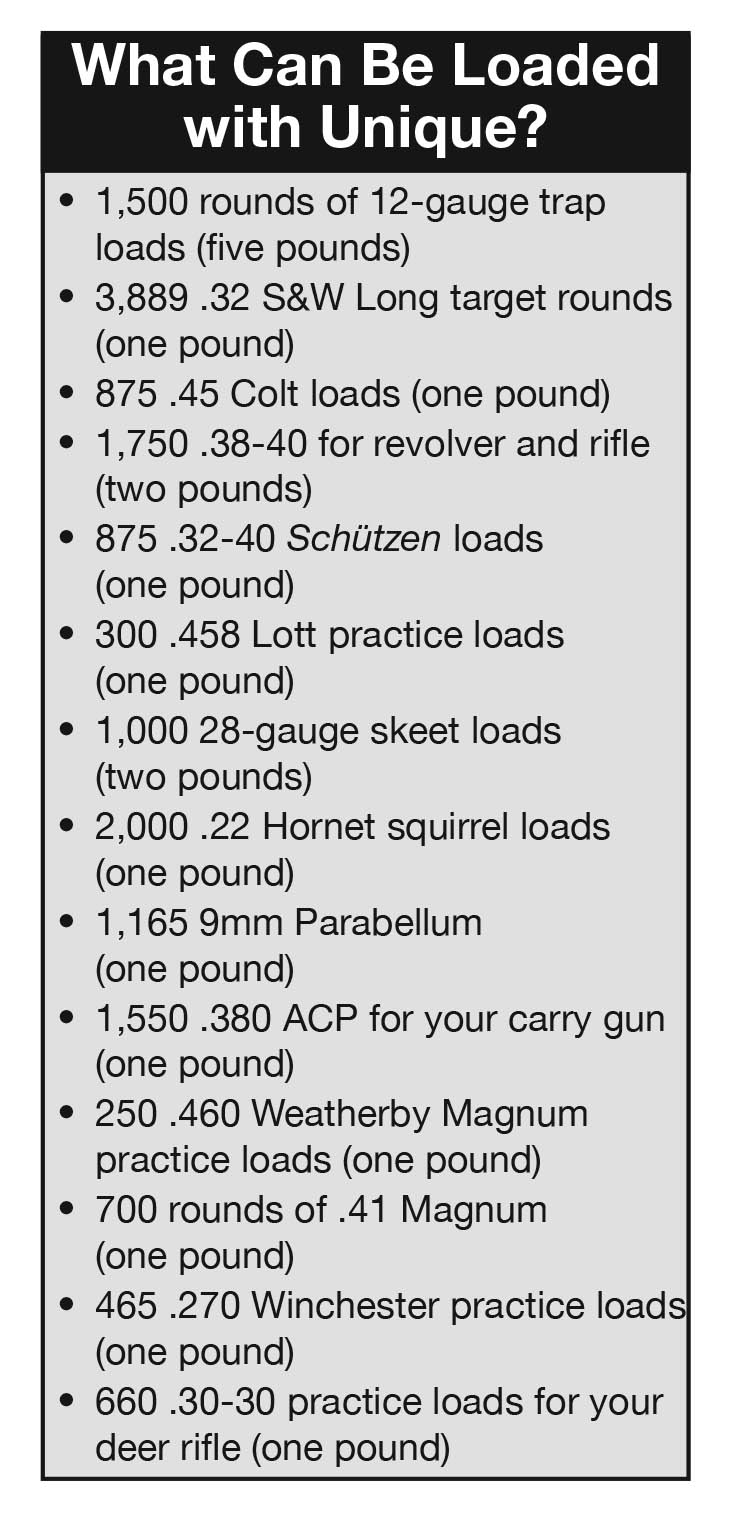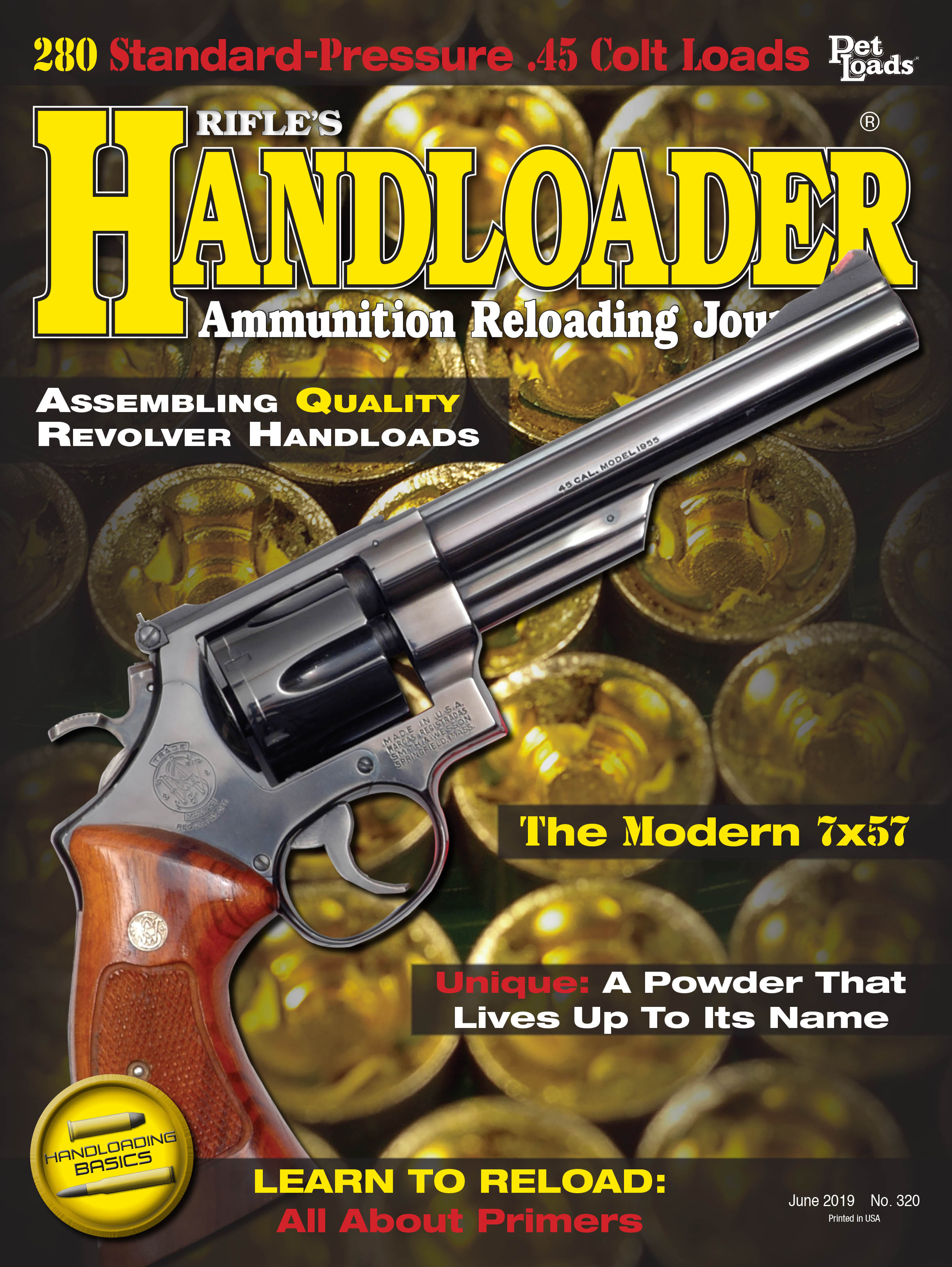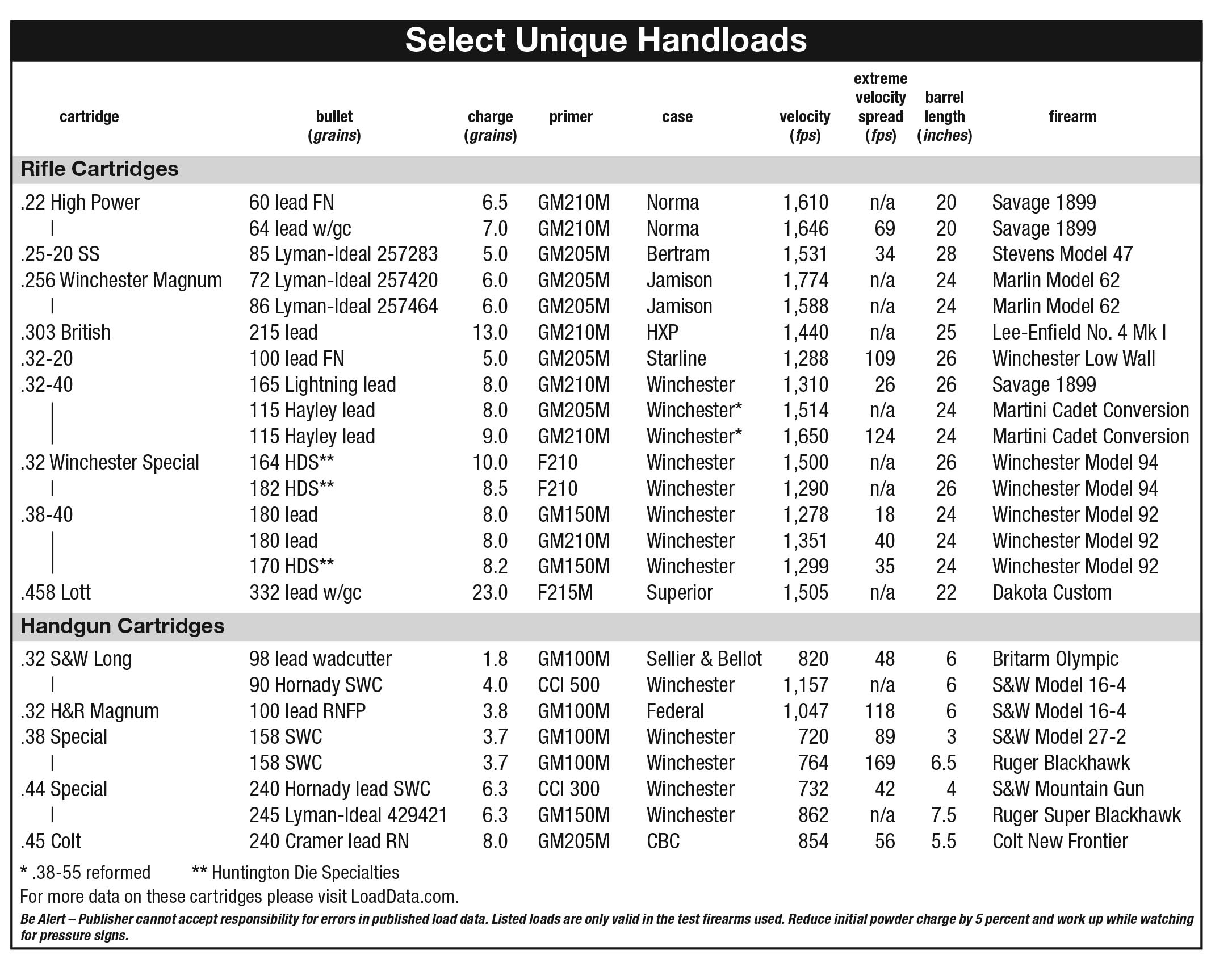Unique Utility
A powder that lives up to its name.
feature By: Terry Wieland | June, 19

The astonishing thing about Unique – which is now made by Alliant but has had a number of corporate parents since its inception in 1899 – is that it’s the second-oldest powder we have, yet it’s still in widespread, regular use. The only powder that is older is Bullseye, another Alliant product created a couple of years earlier. For the last 120 years, both have been standard components for handloaders.

Unique is a double-based flake powder developed by Laflin & Rand, which (along with DuPont) was one of the two largest powder manufacturers in the United States. In 1902, it was taken over by DuPont, which was intent on forming a monopoly. This was broken up under antitrust laws a decade later. The company’s double-based powders then went to a new company, Hercules, which manufactured them until taken over in the 1990s by Alliant.
This is a thumbnail sketch of a history which is incredibly convoluted. To quote Philip B. Sharpe, “The powder industry of the United States is so thoroughly interwoven that it is difficult for a historian to state definitely ‘which firm was which and when’.” Through it all, however, as other notable Hercules powders such as Sharpshooter fell by the wayside, Unique and its running mate, Bullseye, sailed through. Not only that, it has been periodically updated and given new packaging so many times that a collector could devote his time just to Unique containers and have an impressive display.
The latest iteration of Unique was announced by Vista Outdoor, civilian heir to Alliant Powders, in 2018. It is proclaimed to be cleaner burning. If so, I haven’t noticed a

Introduced right at the end of the black-powder era (or the beginning of smokeless, take your choice), Unique occupies a secure position not only as an all-around powder, but one that can be used in many old black-powder cartridges to duplicate original ballistics. It ignites very easily, so fillers are usually unnecessary.
Alliant calls Unique the “most versatile powder made,” and good in “all popular pistol calibers” as well as in 12-, 16-, 20- and 28-gauge shotshells. They don’t mention rifles, but there are many rifle cartridges, too, where a charge of Unique with cast bullets is an efficient, low-cost way to shoot a lot and, generally, shoot pretty well.
As might be expected, a powder with so many applications is not usually the very best powder for any one use. There is a price for versatility and, generally speaking, for any of the cartridges mentioned above another more specialized powder can be found that does the job better. However, there are exceptions.
In the accompanying table is a listing for the .44 Special with a 240-grain lead bullet. In the early 1990s, when I was shooting International Practical Shooting Confederation (IPSC) quite a lot, this was the load I used in my Smith & Wesson Mountain Gun. With the Smith’s 4-inch barrel, this load delivered just enough velocity to make Major power factor. This was in the days before special divisions were devised for high- and low-power guns, and for

I have no idea how many thousand rounds of that load I assembled and put through the Mountain Gun over a couple of years. To this day, it’s my favorite all-around, let’s-go-plinking load for any .44. It’s accurate, very comfortable to shoot, and a pound of powder goes a long way.
Another exception where Unique may be the best powder around is in the .32 S&W Long, using 1.8 grains of Unique behind a wadcutter bullet. Like the .44 load mentioned above, it is very consistent (ES of 48 fps) and accurate in any pistol I’ve tried. As well, a charge of 1.8 grains means you can load, theoretically, 3,888 rounds from a pound of powder.
If loading for power, Unique can do that, too. The load shown for the .45 Colt with a 240-grain roundnose pure-lead Cramer bullet would sure get the attention of anything you cared to shoot. It is also about all the power I care to handle in the Colt New Frontier that I sometimes carry as a car gun. This is one of the famous

Two other 8-grain loads I’ve included are the 165-grain bullet in the .32-40 for use in target rifles, and the 115-grain bullet in the same cartridge for a short-barrel Cadet Martini, rechambered from .310 Cadet. In my experience, neither one is likely to bring home any silverware – I have found more accurate loads for both – but for everyday practice with everyday bullets, Unique does a good and economical job.
Then there is the .38-40, another cartridge that is actually older than Unique and began its career in black powder. Unique substitutes for black very comfortably, delivering better ballistic performance than black powder ever did, with no adverse effects like high pressure to damage older actions.
Notice that several of these cartridges, including the .32-20 and .38-40, were chambered in both rifles and revolvers in the old days, and such combinations are still popular. Here is one of the very, very few instances where a handloader can use the same powder in a rifle and handgun.
The load for the .458 Lott, using a 332-grain cast bullet for practice, is typical of Unique in that application. Although a 23-grain charge comes nowhere close to filling the case, it ignites so readily that no filler is required. Again, if I had my choice for practice ammunition in such cartridges, I would reach for Accurate 5744, especially if I wanted a little more velocity, but in a pinch Unique works just fine. I mention that because at one point it became very hard to get 5744, but Unique always seems to be in stock.
Of course, Unique is a natural for such cartridges as the .32-20, .25-20, .256 Winchester Magnum and the old .25-20 Single Shot, all using cast bullets. Rarely would a handloader ever seek maximum velocity in these guns, and probably never with cast bullets. When you get into really ancient cartridges like the .25-21, where you are likely using brass formed from some other case and capacities are variable, start with a light load of Unique to get the feel of it.

Shotgunners probably think of Unique as primarily a shotshell propellant, which is understandable. To take just one manual as an example, Lyman Shotshell Reloading Handbook, 4th Edition (1995) lists Unique in a wide range of applications. Speaking generally, these are neither the heaviest nor the lightest, the biggest nor
the smallest, in any of the four gauges for which it is recommended. But, it can be used for everything from light target loads to heavy field loads, and it pops up as the “most ballistically consistent” load with monotonous regularity in all four.
Unique has been reviewed in the pages of Handloader at least three times: John Wootters in 1970, Bob Hagel in Handloader No. 95 (Jan/Feb 1982), and R.H. VanDenburg, Jr. in Handloader No. 275 (Dec 2011). It is interesting to compare what they wrote. All agreed on Unique’s great versatility, but Wootters listed a half-dozen rifle calibers as being among his “pet loads,” including the .25-20, .257 Roberts, 7x57, .308 Winchester and .30-06. Not only did it have application in every handgun cartridge from the .25 ACP to the .44 Magnum, he wrote, but it was “the” powder for hot hardball loads in the 9mm Parabellum.
Bob Hagel used Unique for light loads in everything from the .22 Hornet to the .460 Weatherby, while VanDenburg noted that it has applications in an extraordinary range of pressure levels – from 8,000 to 35,000 psi.
Both Hagel and VanDenburg mentioned Unique’s one slight difficulty, and that is metering. Being a light, rather fluffy flake, it tends to be a little inconsistent when metering through a standard powder measure, with the drum occasionally hanging up or the flakes not packing into the cavity. This leads to some variation in powder charges. This is of no real consequence when working with midrange loads, where an extra .2 grains (the range noted in metering tests of Unique) will never show.
In the accompanying table where I list extreme velocity spread, some are genuinely extreme, such as 169 fps with the .38 Special in a Ruger Blackhawk, or 118 fps in the .32 H&R/S&W Model 16-4 combination. That might be due partly to variations in powder charge, but those who have worked with revolvers will recognize this as a common occurrence when dealing with six different chambers.
From the foregoing, it should not be assumed that Unique is suitable only for cast bullets. Good small-game and plinking loads can be assembled using lighter jacketed bullets as well.
Between the loading and the shooting, several pounds of Unique can keep a handloader busy for a good long time.



